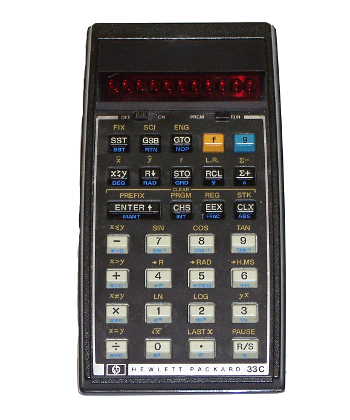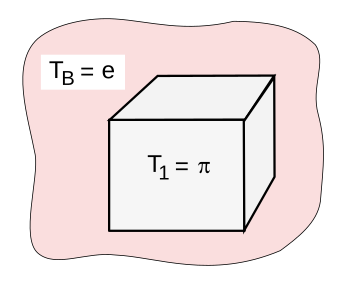Is eπ > πe?
January 22, 2024
During my
high school years, the
slide rule was the
weapon of
choice for
calculation in
science. The modern slide rule has its origin in
Napier's rods. These rods were
engraved with a
logarithmic scale, and
sliding one along another was a means to
add or
subtract logarithms, thereby doing
multiplication or
division. When greater
precision was required, the usual recourse was using values from a
table of logarithms. Slide rules were also engraved with scales for finding values of
trigonometric and other useful
functions.

Mid-twentieth century computing device - The slide rule. The more expensive slide rules were crafted from bamboo. Mid-priced units were aluminum. Most students had plastic versions, such as the one pictured. (Photograph by Roger McLassus, via Wikimedia Commons. Click for larger image.)
When I reached
college, simple
electronic calculators became available. These were called
four-bangers, since they could only add, subtract, multiply, and divide, and they fell short of an
engineer'ss and
scientist's ideal calculator requirements. Eventually some very
expensive scientific calculators came into the
market. When a
National Semiconductor scientific calculator became available for slightly more than $100, this became my first scientific calculator. Finally, as a
corporate research scientist I was able to get a
HP-33C Scientific Programmable Calculator (see image) for
analysis of
xray diffraction data. This calculator cost about a hundred
dollars when purchased in
1980. This is $375 in
today's money, but an equivalent calculator can now be purchased for less than fifteen dollars.

I've retained my HP-33C Scientific Programmable Calculator, no longer working, as a keepsake.
This calculator had a display with an eight digit mantissa and two digit exponent formed from red light-emitting diodes.
Nobel Physics Laureate, Kenneth G.Wilson (1936-2013), about whom I wrote in an earlier article (Kenneth G. Wilson, June 21, 2013), remarked about his purchase of an HP pocket calculator.
"I buy this thing and I can't take my eyes off it, and I have to figure out something that I can actually do that would somehow enable me to have fun with this calculator."[1]
(Photo by author.)
Now to the
topic of this
article, whether
eπ is greater than π
e. The
mathematical constant e is the base of
natural logarithms, and it has a value of about 2.71828. The mathematical constant,
π, also called
Archimedes' constant, is the
ratio of the
circumference of a
circle to its
diameter, about 3.14159. Using an electronic calculator or a
spreadsheet is an easy way to answer this
question; viz.,
eπ = 23.14069...
πe = 22.45915...
A
mathematician would
scoff at such a
crude resolution of the question, since no
proof is involved. An article by
Presh Talwalkar gives a few such proofs, most of which throw a lot of
mathematics at the problem.[2-3] However, one such proof involving a
Taylor series expansion is simple; so, I'll give it here. The Taylor series expansion of e
x is
ex = 1 + x + x2/2! + x3/3! + ...
In a series such as this, when
x is
positive, we know that the
partial sum of any number of the leading terms will always be less than the value of the full series; thus,
ex > 1 + x
If we select as our value for x, (π/e - 1), we find that
eπ/(e - 1) > (π/e - 1) + 1
since
(π/e - 1) + 1 = π/e
and
e-1 = (1/e)
we have
(1/e) eπ/e > π/e
and
eπ/e > π
Then, raising both side of the inequality to the
power of e,
eπ > πe
And, as they say,
quod erat demonstrandum (QED).
A recent paper on
arXiv by
Andrés Vallejo and
Italo Bove of the
Universidad de la República (Montevideo, Uruguay) gives a different proof of this
proposition.[4] This solution is based on the
second law of thermodynamics, the
entropy law.

The thermal environment for the thought experiment demonstrating that eπ > πe. (Created using Inkscape)
The
thought experiment demonstrating that e
π > π
e is based on the
thermal environment shown in the figure. An
incompressible solid A with a constant
heat capacity C is initially at the
temperature T
1 = π. It's immersed in a large
thermal reservoir B at temperature T
B = e.
Equilibrium is reached when the temperature of the solid equals the temperature of the reservoir, at which point the entropy change of the solid is simply computed.
ΔSA = C ln(T2/T1) = C(1 − ln(π))
Thermal equilibrium of the reservoir and solid is achieved by exchanging
heat Q and
energy U.
QB = −QA = −∆UA = C(T1 - T2) = C(π − e)
The entropy change of the reservoir and the total change of entropy of the
system are calculated.
∆S = QB/TB = C(π/e - 1)
ΔStotal = ΔSA + ΔSB
ΔSA + ΔSB = C[(π/e) - ln(π)]
According to the second law of thermodynamics, the total entropy change must be positive.
π/e − log(π) ≥ 0 =>
π ≥ log(πe)
Then, by making both sides of the inequality a power of e, we get.
eπ > πe
References:
- Martin Weil, "Kenneth Wilson, Nobel winner who explained nature's sudden shifts, dies in Maine at 77," Bangor Daily News, June 19, 2013.
- Presh Talwalkar, "Monday puzzle: what is greater: e^pi or pi^e?," MindYourDecisions Blog, August 5, 2013.
- Comparing pi^e and e^pi without calculating them, Mathematics Stack Exchange, Oct 26, 2010.
- Andrés Vallejo and Italo Bove, "Which is greater: eπ or πe ? An unorthodox solution to a classic puzzle," arXiv, September 9, 2023, https://doi.org/10.48550/arXiv.2309.10826.
Linked Keywords: High school in the United States; slide rule; weapon; choice; calculation; science; Napier's bones; Napier's rods; engraving; engraved; logarithm; logarithmic; scale; sliding (motion); addition; add; subtraction; subtract; multiplication; division (mathematics); precision; table (information); trigonometry; trigonometric; function (mathematics); 20th century; mid-twentieth century; computing; machine; device; cost; expensive; manufacturing; crafted; bamboo; price; mid-priced; aluminum; student; plastic; photograph; Wikimedia Commons; undergraduate education; college; electronic calculator; engineer; scientist; ideal; market (economics); National Semiconductor; research and development; corporate research; HP-33C Scientific Programmable Calculator; data analysis; X-ray crystallography; xray diffraction; data; dollar; 1980; inflation; today's money; souvenir; keepsake; seven-segment display; numerical digit; significand; mantissa; floating point; exponent; light-emitting diode; Nobel Physics Laureate; Kenneth G.Wilson (1936-2013); discourse topic; blog article; e (mathematical constant); pi; π; mathematical constant; natural logarithm; Archimedes; ratio; circumference; circle; diameter; spreadsheet; question; mathematician; scoff; crude; problem solving; resolution; mathematical proof; Presh Talwalkar; Taylor series expansion; sign (mathematics); positive; series (mathematics); partial sum; exponentiation; power; quod erat demonstrandum (QED); arXiv; Andrés Vallejo; Italo Bove; University of the Republic (Uruguay); Universidad de la República (Montevideo, Uruguay); conjecture; proposition; second law of thermodynamics; entropy; thermal reservoir; thermal environment; thought experiment; Inkscape; compressibility; incompressible; solid; heat capacity; temperature; thermodynamic equilibrium; heat; energy; thermodynamic system.